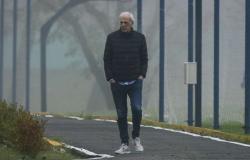Reading time: 6 minutes
In the success of the Slovenian Tadej Pogacar at Liège-Bastogne-Liège on Sunday, his sixth monument race in his career, there is obviously also the signature of Colnago. The champion of UAE Team Emirates ran on the chassis V4Rsan all-rounder model from the Brianza brand that stands out for its lightness and reactivity.
Let’s find out in detail, and in particular in the setup. As we will see, it offers components that are anything but conventional, even in the professional field.
The Colnago V4Rs frame
We presented the V4Rs to you at the time of its official release via this video for the Cicloturismo website in December 2022. The version currently marketed is the so-called “survivor” of five prototypes that made their debut, even if in a completely different way how official, at the Tour de France that year.
The shapes are very reminiscent of those of the V3Rs that preceded it, starting with the design of the structure. Colnago’s step forward was first and foremost to further lower its weight. The main triangle remains almost identical, 798 grams, but the fork drops from 390 to 375 grams, so the complete framekit reduces from 1,185 to 1.173 grams.
But it is on the structural details that the work was most concentrated. The fork itself has been significantly strengthened in the stays, allowing the transit of tires up to 32 mm section. Not only that, it is also more reactive on the lateral axis, details that can be felt when lightning-fast shots and sudden accelerations need to be produced.
The other end of the bicycle, the rear stay, still has the pendant connection positioned at the bottom, but in a more massive and rounded connection. Almost as if it were a monostay (even if it isn’t actually one).
Other changes compared to the V3Rs are the adoption of a 1.5 inch bearing also on the top of the head tubeand the standard bottom bracket T47.
The V4Rs is offered in 7 sizeswith a steering angle that is basically more open than its predecessor but with a set-up that can be defined as racing.
The aerodynamic details
On an aerodynamic level, the V4Rs was born from the collaboration between Colnago and the Politecnico di Milanoand from an approach that can be summarized as that of recreating a situation of “real race”. Such as the adoption of the double bottle cage mounted but only one bottle present in the “configuration” in the wind tunnel. The best results arrived and then “frozen” from one corner of Yaw Of 15 degrees. The Yaw can be summed up, in a very big way quickas the force that opposes the cyclist’s progress. It is calculated taking into account the wind direction, speed and direction of travel.
The Colnago V4Rs would be born together with its “own” handlebar, the CC.01but in the UAE Team Emirates bicycle we find the brand Hello, who also signs the wheels. The integrated in this case is a top of the range model, the SES AR monocoque that is made entirely by hand directly in Ogden, Utah. The weight is 380 grams approximatelyand above all it proposes a flare of the bass terminals Of 18 angular degrees, corresponding to 5 centimeters. A component that costs $1,200.
The wheels are no different, and also come from the Enve range. Those used at Liège-Bastogne-Liège are the SES 4.5cost of $2,850. the set for a weight of 1,432 grams. Intended for hilly routes, they have a differentiated profile of 50 millimeters at the front and 56 at the rear, with an internal channel of 25 which makes them suitable for tires of at least 27 millimetres. And speaking of covers…
A time trial tubeless
The choice of covers is singular, but not too much when you think about it. UAE Team Emirates has Continental as a supplier, and for the Doyenne the Slovenian chose a variant of the Grand Prix 5000 TR. It’s about the TTwith that suffix which stands for “Time Trial“, a tubeless tire intended for time trials and time trials.
Distinguished by the compound Black Chiliwhich is a mix of natural and synthetic rubbers with high grip and smoothness, in the 28 mm section weighs 245 grams, about thirty less than the standard road model. Even if it has a lower longevity in terms of kilometres, the very soft compound proved to be ideal for the inclement weather conditions in which it was raced in Belgium.
For the saddle the choice of Pogacar, placements aside, fell on Prologue Nago R4. From the fourth evolution of a very popular model among professionals, the Slovenian has chosen the version 147 mm wide (by 245 long). And here we also understand some additional details regarding Tadej’s habits.
In fact, this model has a slightly advanced anatomical center, so as to offer good freedom of movement in all positions in which one may find oneself sitting. It has a T shape and a semi-round shape, but above all it has increased padding of 10 millimeters on the sides and 3 in the upper section compared to the 137 millimeter model. A sign that, champion numbers or not, Pogacar does not give up comfort.
File the gram
The very last detail concerns the transmission. UAE Team Emirates uses the Shimano Dura Ace Di2and Pogacar at Liège chose a rear cassette 11-30combined with an anterior dentition 55-40. A configuration that allows you to cover a very wide range of ratios. They range from the most agile metric development, the 40/30 corresponding approximately to 2.85 meters, to the 10.68 of the 55/11.
But it is the two chainrings that have aroused curiosity, especially among lovers of tuning and the possibility of shaving even a single gram from the bicycle. Especially on one component, the crankset which Pogacar recently brought into the limelight for its choice to opt, from the beginning of the year, for the length of 165 millimetres.
Instead of the standard Shimano Dura Ace plateaus (of which both the spider and the integrated power meter remain) here we find some X-CarboRing EVO Of Carbon-Tian Italian brand that is a partner of the team.
Both the internal and external ones are made of 7075-T6 aluminum for the part that comes into contact with the chain. The carbon fiber represents a real structural element (among other things customized) with a glossy 3K finish and grade 5 titanium pins.
But that’s not the only Carbon-Ti element on Pogacar’s bike. There are also the two discs, the X-Rotor SteelCarbon 3, with internal composite spider and external steel spider. Which weigh 98 grams in the 160 mm diameter used at the front, 16 less than the Shimano counterpart.
For information: www.colnago.com





